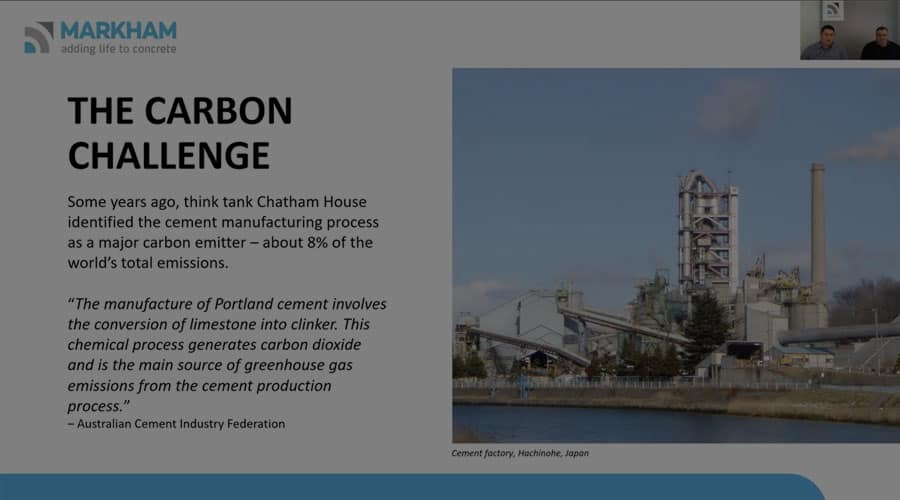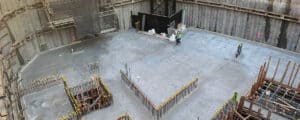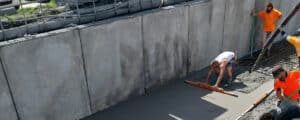The Concrete Carbon Challenge

The Concrete Carbon Challenge
Webinar Show Notes
Calculator – embodied carbon in concrete circularecology.com/concrete-embodied-carbon-footprint-calculator.html
Sustainability and Concrete markhamglobal.com/sustainability-and-concrete-2/
Learning Outcomes
- The carbon challenge.
- Concrete’s ongoing use.
- An approach to mitigate the impact.
CONRAD: Hello and welcome everyone. Looks like we can start now. Great to have you all on board with the MARKHAM panel today. I’m Conrad from the marketing team in Bundaberg, Australia and we’ve got Martin Prestidge and Doug Hamlin joining us virtually from the Napier office.
Martin, could you tell the audience a bit about yourself? – A bit about your role at Malcolm.
MARTIN: Thanks, Conrad. Hello everybody! Yes, Martin Prestidge. Been with MARKHAM for thirteen odd years, mainly work in the civil infrastructure space, remediating concrete projects developed in the marine sector – bridges, wharves, tunnels. Any large lumps of concrete, really.
Thanks for coming along today. I’m no expert on the carbon movement, it’s just a few things we’ve picked up along the way. Thanks, Conrad.
CONRAD: Thanks for that Martin. That’s great. And what about you, Doug?
DOUG: Yes, I’m on similar lines to Martin, so work in the infrastructure industry space here at MARKHAM. So that’s adding service life to existing and new structures. And also involved in the sort of, the technical validation side of things, and yes, likewise with Martin, I’m haven’t got a degree or anything in carbon emissions, that type of thing, but it’s yet some thoughts; and really, a thought-provoking session I guess you’d call it. So yes, back to you, Conrad.
CONRAD: Thanks for that Doug. Today we’re talking about the concrete carbon challenge and what this involves and some practical responses. I’ll be hitting our panellists with some questions about the practical challenges and their experience in the field. We will open the door for guests’ questions later in the presentation, so please use the Q&A button at the bottom to answer your questions as we go along.
So Doug, to kick us off, could you tell us what we mean when we talk about the concrete carbon challenge? What’s the context around this issue?
DOUG: Yes, sure thing, thanks, Conrad. So yes, it really bears on the science around the carbon emissions that’s at the heart of this climate change topic. For concrete. It’s a well-known issue that’s been highlighted a few years ago now, that it’s the manufacture of the cement itself that is the bad boy or is the biggest contributor, if you like, to the carbon emissions of the overall concrete production, and the Australian Cement Federation, there you can see they say, they confirmed that that’s the process that generates the most carbon dioxide. So that’s when they’re making or manufacturing the cement, there’s a lot of heat required in the kilns to, you know, to convert the limestone into clinker, and then into the finished product, cement. So that is the major factor that contributes to the carbon emissions here. And there’s been, I think, one or two studies on that as an overall contributor. It’s around about 8% of the world’s total emissions, or that’s what they, that’s alleged to be. So yes, that is a significant amount for, you know, for one product or material, if you like. But yes, does that make sense?
CONRAD: Yes it does. That’s a pretty heavy amount. So what would we use if we removed concrete from the equation?
DOUG: Yes, that’s a great question, and it’s a very real challenge. Obviously concrete. I mean, it’s everywhere, you don’t have to look too far to see some. It is very robust, it’s durable, it’s a very versatile material, so you can use it… There are so many different applications you know, basically right from the floor to walls to ceiling to roof, and it’s quite dynamic in that way.
So it’s quite a challenge to find something that replaces it entirely, so is a building material that is more carbon-friendly that, you know, replaces concrete entirely.
And obviously, there’s a bit of a move to use more other things like timber in structures. Obviously, that’s fair, I mean it’s been going for a few years now. But it’s still fairly early days.
It’s not as versatile, so you can’t use it everywhere you can use concrete. And, you know, the data around the longevity for you know, like a high rise building or something like that… There is starting to build up, that data, but there’s not a lot known there at the moment.
I mean the other thing from a personal point of view, the forests as used to sequester carbon and you know offset that carbon emission. So yes, I would raise that question, is there actually enough renewable forest out there to turn over for milling and use that timber in the construction industry? So like I say I’m not an expert on this topic, but it’s these kinds of questions that I would raise and think about.
So yes, that’s probably the main couple of points there. If you don’t use concrete what do you use? Any other points on that?
MARTIN: No, I think you’ve covered it well. Timber’s making good ground. And then there are a few things concrete companies are doing that would be linked with that, to save on cement use. But I think the reality is concrete is always going to be with us in some shape or form.
CONRAD: That’s good, so what other factors should we be considering?
DOUG: Yes, so I think if we go back to the concrete… as Martin said, it’s going to be with us for a long while yet. I think we really need to look at that bigger picture, so look at the entire life cycle of concrete, or a concrete structure. If you look at it that way, it does have a low embodied energy per unit of mass. That means the carbon involved in transport, that type of thing, is not really high. If you think about it, a concrete plant – they’re generally fairly close to a construction site, and that’s just one example. And you know, so you can reduce down that overall impact. While the cement might be quite high, that is something to consider. The fact that it reduces the overall contribution. If you like. Martin, you got any thoughts on that one?
MARTIN: Thanks Doug, I think what you’re highlighting, focussing on concrete total emissions, it’s a carbon-expensive product to be using concrete. And if we look at … I think we probably need a mind shift on using it more wisely, so the service life of the structures; the longer we can extend the service life of the structure, the overall carbon impact reduces down. So if you’re going to be spending carbon expensive, if you like, material like concrete, to be able to produce an end product that lasts, you know, start challenging some of the service life. Push it out to 100 years, 150 years through some of the newer technologies and some of the admixtures, that kind of thing.
And on the same token, existing concrete structures that are already in place, to be able to keep them, keep the longevity, keep the service life-extending past where they might have been designed, by applying some newer technologies.
If you look at the expansion of the global population, there’s a shortage of infrastructure globally; so the environmental impact of having to knock down and re-build existing infrastructure, as well as keeping up with the expanding global population. Anything we can do that extends the service life of existing concrete structures has to be contributing positively.
DOUG: Yes, 100%. And if you think about that in terms of… I’m assuming most people would have seen a concrete structure that’s deteriorating over time. Might be 40-50 years old. If you think about the, not only the monetary cost but the carbon cost to replace that! For one, you’ve got to get rid of the existing, the old concrete. Some of it might be able to be recycled, but you know, what happens to the rest of it? There are the emissions associated with demolition and then you’ve got to rebuild that structure. I’m actually talking worst case here, but you’ve got to use a whole lot more new concrete. So you know need to really shift that focus, to look after what we’ve got, in terms of infrastructure; and then, you know, if we do build new infrastructure, make it … do something right at the construction phase to ensure that you get that concrete life. I think you’ve got a few thoughts around maybe not just hitting code, but really pushing it a bit further in new concrete?
MARTIN: Yes I think so. Often because of cost constraints with developers and asset owners, which is a legitimate restraint, they’re often meeting just code. Now codes, for concrete structures, they’re great for their durability, but there is more that can be done, so if you take it past the code – for a little more expenditure, we’re not talking a lot. We’re talking about spending a dollar during construction; it saves $125 during the remediation phase further down the track. So you know, spend a couple of extra dollars during construction, putting in some admixtures, some surface treatments, that kind of thing that would just extend that life cycle. It’s a huge impact over the lifespan of the structure.
DOUG: Yes, that’s good. That’s good; and they also … obviously there’s a lot of things that go into concrete construction, like the design, the mix design, that type of thing, and what we are seeing from a lot of the major readymix suppliers is that they’re wanting to reduce the overall cement consumption, and obviously that’s a major contributor, and it really brings up another topic of …
Take, for example, a wharf project, or a bridge, for that matter. The codes for that bridge might say a 50 or 60 MPA bridge will give you a 50-year design life. What we really need to look at is the actual strength required structurally for the project; so, to take the loads, that type of thing. A lot of the time it’s only around that … between 30 and 40 MPA that is required. Obviously concrete has got a very good compressive strength. And so there’s quite a shift in focus to look at using, say, a lower MPA concrete, but working with that mix to get it to perform as good as a 50 or 60 MPA concrete in terms of durability.
So yes, that’s really a question, or a challenge, really, to engineers or asset owners to think about; that when you’re, you know, looking at new infrastructure or new builds, can we actually reduce that MPA and work on a performance specification rather than just setting to code? I mean, we’re not bagging the code, but in reality, there’s a lot of structures that are built to code, and we go back and remediate them for concrete corrosion. Is that not too harsh to say?
MARTIN: No, I think the average structural engineer would agree with that; you can build to code, but you’ve got to monitor from day one, pretty much, and we’re getting call-backs earlier and earlier to jobs; that’s just the way the trend is going.
I think, just to put a plug in for concrete companies… So traditionally their role has been to sell as much concrete as possible. They are all actively pursuing ways they can bring the cement down, and still provide the same service.
So like you say, you can dial up a project. So say you only need a 35 MPA to satisfy the structural requirements of the project; it becomes extremely expensive carbon-wise to take it to 60 [MPA] just to keep chlorides or environmental contaminants out when you could do that with a very carbon-low-impact admixture or something like that, so there’s definitely advances being made.
DOUG: 100%, I second that. There’s a lot of the people we talked, you know, working on ways to reduce that. So you do want to say something about some of our newer … Obviously, we’ve got a range of admixtures for concrete protection, that’s what we do. But some of the newer admixtures we’re working on, Martin, they do have even lower impact. Do you want to run us through – obviously run us through a little bit … the admixtures for a start, but the new ones.
MARTIN: Do you have the slide there, Conrad, on the hydrogel?
CONRAD: Just get the slide open, did you say?
DOUG: Yes – yes, this one.
MARTIN: Yes, thank you very much.
So as a company, MARKHAM, our main technology is using colloidal silica, and we either spray-apply it to the surface, or add it as an admixture into the concrete. The picture you’ve got up there is showing the network, or vein system, of the concrete.
One of the issues with concrete, or the main issue with concrete, is its permeability, so it lets moisture in and out. Now just about every issue with concrete that’s going to shorten its design life, is due to moisture being able to be carried in and out of the matrix of the concrete; and taking the contaminants in with it. It’s just the nature of concrete. When the bleedwater comes out of these network systems, the moisture can get back in.
If we can fill those porosities, capillaries, block them up, we’re stopping moisture and contaminants getting in. We’re extending the life of the concrete, taking moisture and oxygen out of the equation from corrosion, but also the more expansive ASR, DEF, the other common issues that we have with concrete, they’re all moisture fed.
So what the product does – we’re talking existing now – we clean the surface down; spray-apply colloidal silica. It gets down, carried down in the colloidal form, down into the porosities; mixes reacts with the calcium hydroxide and forms a gel, into a solid-state; blocking those capillaries off.
We can do the same thing with an admixture, going in at the start, in the back of the truck, and getting that colloidal silica right through; so that the gel forms and the porosities are blocked from day one.
Did you want to say something about the actual impact of the colloidal silica itself?
DOUG: Yes, thanks for that overview. So when we look at … talking about admixtures to concrete, so typically with colloidal silica, there are some carbon emissions associated with that, in terms of the heat required to manufacture them. You know, even if you take that into account because you’re only using one to two litres per cubic metre of concrete, even though it has some impact that there’s. Even when you take it over a, you know, over a whole cube of concrete per se … even though it’s obviously a whole lot lower than the cement itself, there is some carbon impact.
So what we’ve come to as a progression on that, we’ve actually started working with a company right here in New Zealand that harvests the colloidal silica right from the geothermal fluids, that’s used for power generation. Now, this was silica that, if it’s not taken out, actually works to clog up the pipes and reduces their capacity, so the overall power generation capacity drops. So being up with this company, harvesting the colloidal silica out of that fluid, and it’s not only helping the power company, but it also means that it’s a very, very low impact, carbon impact for the raw material. So we were able to take that back to our head office factory in Napier; tweak it, modify it and make it do what we needed it to do in concrete; and then use that to put into new concrete; and as Martin discussed, waterproof, fill up those pores, porosities, so that moisture can’t get through the concrete and, you know, therefore pushing that life, that service life out, of the concrete structure. So is that making sense?
MARTIN: Yeah, so it’s an exciting product; as you said, it’s actually being harvested from steam that’s coming out of the ground. You can’t get much more environmentally friendly than that. But when you put it up against some of the other products that they’re using to replace cement. So cement is obviously the bad boy. But then you’ve got microsilicas, flyash, they have a lot of carbon impact. And then you can replace those with the colloidal silica. You’re dropping the carbon footprint of the corporate structure considerably, but giving the same performance.
DOUG: Yes. Is that making sense, Conrad?
CONRAD: It’s very interesting, actually. I can see how that approach would save time, because after all, making this structure last longer is reducing its lifetime environmental impact. You don’t need to rebuild a structure and use more cement. I appreciate you taking the time to help us with that.
We’ve got some live questions just come in. And one is: Could you give more details on the practices or process that you are using to extend the service life of concrete. In terms of percentage using the processes you are using now, could you estimate by how much could the service life of a structure be extended?
MARTIN: Yes, thanks. That’s a great question. A lot goes into the service life of the structure, so there’s obviously the environment that the structure’s in. And then the construction methods that kind of thing. So it’s hard to put a percentage per save on how much we can extend the concrete structure, life cycle. But if you take it over against a standard bridge structure. We’ve been up… We offer 25 years, 50 years; we were involved in a job that we did for the Brisbane Port, MARKHAM was involved, with a 100-year design life. We’re working with LendLease on a similar job. So yes, it all depends. It’s hard to … We’re a very project-specific company. So we like to involve at the specification stage and just see what you’re trying to do. But if it’s in the marine environment, it’s under some sort of chemical attack, or in an industrial situation; and then we can answer more categorically what you hope to achieve.
CONRAD: OK, thank you. There’s another … next question is, Do you have products which would save, say, deteriorating old concrete buildings and give them a new life, new use?
DOUG: Yes, definitely. So there is… Obviously, we’ve talked a lot about the admix for new concrete. Getting it right from day one. But there’s a lot – similar technology, but it’s spray-applied to the concrete, and that can arrest that deterioration process, and hold it in that condition that it is currently. So if it is in a satisfactory condition or, you know, a structure might need a few repairs to get it into a satisfactory condition; and we can hold it at that, at that point.
And then obviously, as Martin said, it’s very project specific on terms of service life extension. But yes, we always like to get, you know, a definitive number of years that we can extend that service life. And obviously, we aren’t structural engineers, and we aren’t durability experts, so we’re talking about, in terms of durability, not if the structure is going to cope with the loading or that type of thing.
Next one, Conrad.
CONRAD: And so there’s the next question is, Is it available in Western Australia?
MARTIN: Yes. MARKHAM, as Doug said, we manufacture the product here in Napier. We partner with our raw material suppliers. Then we export right across Australia; so we’ve got offices in Perth, Melbourne, Sydney and Bundaberg. And anywhere we haven’t got an office, we’ve definitely travelled and have applicators on the ground; right across New Zealand, the UK and through Southeast Asia.
CONRAD: That’s good, that’s quite widespread around Australia and Australasia. There’s another question: How does the admix compare in price, instead of using a high MPa mix?
MARTIN: Coastwise, it’s pretty much cost-neutral. So talking a standard, say 35-40 MPA mix compared to 60 MPA mix. By putting our admixture in, you’re not putting the price of the project through the roof at all. And probably – I’d like to say, potential savings. But if you work on cost-neutral. You think, Doug?
DOUG: Yes. There are a lot of variables as well, in any project.
CONRAD: Cool! Next question is, Where can I find information on how much embodied carbon is in a cubic metre of concrete? Is there a table somewhere?
DOUG: Yes, I was definitely just looking at this a couple of days ago. If you’d like to flip me an email, whoever asked that question, I can send that link through.
MARTIN: There’s quite a bit of debate about how it’s measured, as well. It’s an interesting topic, probably don’t have time to get into it now, but there’s definitely numbers out there, readily available, on how much embodied carbon is in concrete.
CONRAD: That’s [email protected], if you want to email him.
DOUG: Thanks.
CONRAD: There’s quite a detailed question on ICF; we may have to answer that one offline.
DOUG: Yes, that would be good, sounds interesting.
CONRAD: Another question is, I am based in the Melbourne construction industry where we have quite a lot of crystalline admixtures being asked for in a lot of projects. What is the carbon footprint of these? Do you provide crystalline admixtures?
DOUG: Yes, I don’t know the exact carbon footprint of crystalline products. We work with hydrogel admixtures ourselves, which are kind of a more advanced version of the crystalline, so they’re using a smaller nanoparticle, and less of it, to get the same or better results. Martin?
MARTIN: Yes, I haven’t seen exact numbers. It’s a powder form, and that has to have a lot, I mean the process to generate it, it’s going to have a high carbon… The other challenge with crystalline is the health and safety, so they’re actually carcinogenic. So we’re seeing a lot of that coming through as well, but it’s a good question.
CONRAD: Yes. The last question I think we’ve got is, A lot of warehouse projects and large slabs ask for rubber-based curing compounds. Is there a better alternative to this?
MARTIN: Yes, there sure is. So chlorinated rubber for curing. You can use colloidal silica spray-applied, in a different format to what we use for durability, just as a straight curing product. So similar to a, or it’s equivalent to a 14-day water cure. You spray it on, and it gets down and sets up the hydrogel, and it helps hydrate the cement particles; traps the moisture in there during the curing process. And that setting up that hydrogel, it’s doing everything you want from a … It’s better than a curing compound. That’s why we compare it with a [14-day water cure] because it actually holds moisture inside the slab for that period. That’s a good question.
CONRAD: I think that’s all the questions we had. That’s very good. Is there anything you’d like to add at the end or finish up on that?
DOUG: Not from me. Thanks, thanks everyone for attending, it’s most appreciated!
CONRAD: Yes, thank you very much.
MARTIN: Thank you everybody, and just reach out if you’ve got any other areas; but it’s a big topic.
Our tagline is, Saving the World One Concrete Structure at a Time. So if you got any ideas how we can improve on this? How we can reduce our own carbon impact, and get a bit more exposure? Then definitely reach out. Thanks for coming along!
CONRAD: Thank you, thanks for panelling!
More about MARKHAM
MARKHAM are dedicated to providing innovations for concrete and construction. Focusing on concrete waterproofing solutions, penetrating concrete sealers and durability treatments concrete.
Invisible Strength – The media site for MARKHAM – Adding Life to Concrete.
At MARKHAM, we’re on a mission to transform concrete and construction. Our Purpose? ADDING LIFE TO CONCRETE.
From innovative waterproofing solutions to penetrating hardeners and sealers, our focus is clear: to reinforce concrete structures and make them withstand the test of time.
Newsletter
Sign up for email updates on the latest collections, campaigns and videos.





